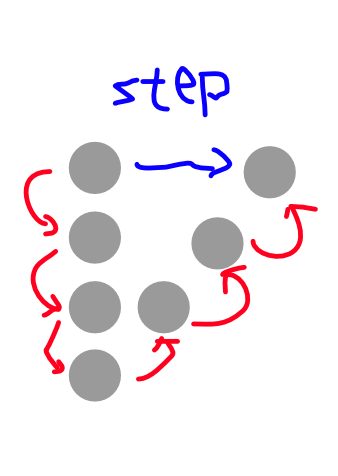LeetCode 6. ZigZag Conversion ( C )-Medium
Posted On 2021 年 5 月 4 日
題目為給定一個字串,把該字串照 zigzag pattern (鋸齒型) 排列,
如下圖所示依照紅色箭頭依序排列,此圖假設 Row 為 4,並依照排序後的每一列 ( Row ) 字元輸出,可以參考下方題目原文的範例。

題目與範例如下
The string "PAYPALISHIRING" is written in a zigzag pattern on a given number of rows like this: (you may want to display this pattern in a fixed font for better legibility)
P A H N
A P L S I I G
Y I R
And then read line by line: "PAHNAPLSIIGYIR"
Write the code that will take a string and make this conversion given a number of rows:
string convert(string s, int numRows);
Example 1:
Input: s = "PAYPALISHIRING", numRows = 3
Output: "PAHNAPLSIIGYIR"
Example 2:
Input: s = "PAYPALISHIRING", numRows = 4
Output: "PINALSIGYAHRPI"
Explanation:
P I N
A L S I G
Y A H R
P I
Example 3:
Input: s = "A", numRows = 1
Output: "A"
Constraints:
1 <= s.length <= 1000
s consists of English letters (lower-case and upper-case), ',' and '.'.
1 <= numRows <= 1000我的解題策略為,依照列 ( Row ) 一列一列輸出,透過 Step 做跳躍, Step 的大小為 ( numRows – 1 ) x 2 ,並於第二列之後採用先輸出減 row 的值,在輸出加 row 的值,並於最後一列 ( Row ) 時,保護不重複輸出。
下面是我的程式碼
char * convert(char * s, int numRows){
if(strlen(s) == 1 || numRows == 1)
return s;
int step = (numRows-1)*2, rIndex = 0,strl = strlen(s);
char *r = (char *)malloc((strl+1)*sizeof(char));
r[strl] = '\0';
for(int i = 0;i<numRows;i++){
int jump = 0;
while(jump<strl){
if(jump+i<strl && i!=(numRows-1)){
r[rIndex] = s[jump+i];
rIndex++;
}
jump+=step;
if(jump-i<strl && i!=0){
r[rIndex] = s[jump-i];
rIndex++;
}
}
}
return r;
}
下面是時間與空間之消耗
Runtime: 0 ms, faster than 100.00 % of C online submissions for ZigZag Conversion.
Memory Usage: 6.5 MB, less than 86.07 % of C online submissions for ZigZag Conversion.